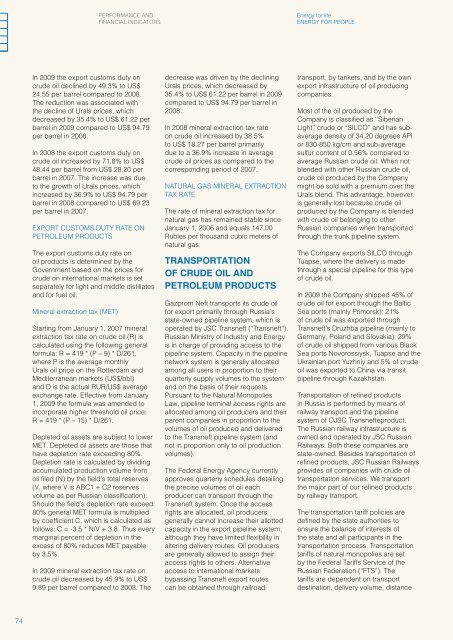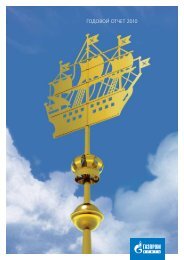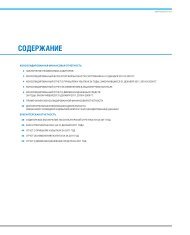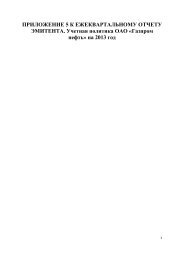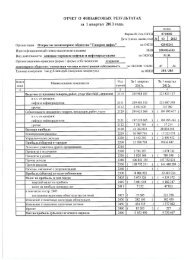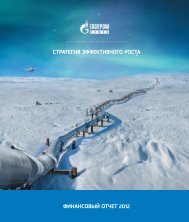ENERGY FOR PEOPLE - JSC Gazprom Neft
ENERGY FOR PEOPLE - JSC Gazprom Neft
ENERGY FOR PEOPLE - JSC Gazprom Neft
You also want an ePaper? Increase the reach of your titles
YUMPU automatically turns print PDFs into web optimized ePapers that Google loves.
PER<strong>FOR</strong>MANCE ANDFINANCIAL INDICATORSEnergy for life<strong>ENERGY</strong> <strong>FOR</strong> <strong>PEOPLE</strong>In 2009 the export customs duty oncrude oil declined by 49.3% to US$24.55 per barrel compared to 2008.The reduction was associated withthe decline of Urals prices, whichdecreased by 35.4% to US$ 61.22 perbarrel in 2009 compared to US$ 94.79per barrel in 2008.In 2008 the export customs duty oncrude oil increased by 71.8% to US$48.44 per barrel from US$ 28.20 perbarrel in 2007. The increase was dueto the growth of Urals prices, whichincreased by 36.9% to US$ 94.79 perbarrel in 2008 compared to US$ 69.23per barrel in 2007.Export customs duty rate onpetroleum productsThe export customs duty rate onoil products is determined by theGovernment based on the prices forcrude on international markets is setseparately for light and middle distillatesand for fuel oil.Mineral extraction tax (MET)Starting from January 1, 2007 mineralextraction tax rate on crude oil (R) iscalculated using the following generalformula: R = 419 * (P – 9) * D/261,where P is the average monthlyUrals oil price on the Rotterdam andMediterranean markets (US$/bbl)and D is the actual RUR/US$ averageexchange rate. Effective from January1, 2009 the formula was amended toincorporate higher threshold oil price:R = 419 * (P – 15) * D/261.Depleted oil assets are subject to lowerMET. Depleted oil assets are those thathave depletion rate exceeding 80%.Depletion rate is calculated by dividingaccumulated production volume fromoil filed (N) by the field’s total reserves(V, where V is ABC1 + C2 reservesvolume as per Russian classification).Should the field’s depletion rate exceed80% general MET formula is multipliedby coefficient C, which is calculated asfollows: C = -3.5 * N/V + 3.8. Thus everymarginal percent of depletion in theexcess of 80% reduces MET payableby 3.5%.In 2009 mineral extraction tax rate oncrude oil decreased by 45.9% to US$9.89 per barrel compared to 2008. Thedecrease was driven by the decliningUrals prices, which decreased by35.4% to US$ 61.22 per barrel in 2009compared to US$ 94.79 per barrel in2008.In 2008 mineral extraction tax rateon crude oil increased by 38.5%to US$ 18.27 per barrel primarilydue to a 36.9% increase in averagecrude oil prices as compared to thecorresponding period of 2007.NATURAL GAS MINERAL EXTRACTIONTAX RATEThe rate of mineral extraction tax fornatural gas has remained stable sinceJanuary 1, 2006 and equals 147.00Rubles per thousand cubic meters ofnatural gas.Transportationof Crude Oil andPetroleum Products<strong>Gazprom</strong> <strong>Neft</strong> transports its crude oilfor export primarily through Russia’sstate-owned pipeline system, which isoperated by <strong>JSC</strong> Transneft (“Transneft”).Russian Ministry of Industry and Energyis in charge of providing access to thepipeline system. Capacity in the pipelinenetwork system is generally allocatedamong all users in proportion to theirquarterly supply volumes to the systemand on the basis of their requests.Pursuant to the Natural MonopoliesLaw, pipeline terminal access rights areallocated among oil producers and theirparent companies in proportion to thevolumes of oil produced and deliveredto the Transneft pipeline system (andnot in proportion only to oil productionvolumes).The Federal Energy Agency currentlyapproves quarterly schedules detailingthe precise volumes of oil eachproducer can transport through theTransneft system. Once the accessrights are allocated, oil producersgenerally cannot increase their allottedcapacity in the export pipeline system,although they have limited flexibility inaltering delivery routes. Oil producersare generally allowed to assign theiraccess rights to others. Alternativeaccess to international marketsbypassing Transneft export routescan be obtained through railroadtransport, by tankers, and by the ownexport infrastructure of oil producingcompanies.Most of the oil produced by theCompany is classified as ‘‘SiberianLight’’ crude or “SILCO” and has subaveragedensity of 34.20 degrees APIor 830-850 kg/cm and sub-averagesulfur content of 0.56% compared toaverage Russian crude oil. When notblended with other Russian crude oil,crude oil produced by the Companymight be sold with a premium over theUrals blend. This advantage, however,is generally lost because crude oilproduced by the Company is blendedwith crude oil belonging to otherRussian companies when transportedthrough the trunk pipeline system.The Company exports SILCO throughTuapse, where the delivery is madethrough a special pipeline for this typeof crude oil.In 2009 the Company shipped 45% ofcrude oil for export through the BalticSea ports (mainly Primorsk); 21%of crude oil was exported throughTransneft’s Druzhba pipeline (mainly toGermany, Poland and Slovakia); 29%of crude oil shipped from various BlackSea ports Novorossiysk, Tuapse and theUkrainian port Yuzhniy and 5% of crudeoil was exported to China via transitpipeline through Kazakhstan.Transportation of refined productsin Russia is performed by means ofrailway transport and the pipelinesystem of O<strong>JSC</strong> Transnefteproduct.The Russian railway infrastructure isowned and operated by <strong>JSC</strong> RussianRailways. Both these companies arestate-owned. Besides transportation ofrefined products, <strong>JSC</strong> Russian Railwaysprovides oil companies with crude oiltransportation services. We transportthe major part of our refined productsby railway transport.The transportation tariff policies aredefined by the state authorities toensure the balance of interests ofthe state and all participants in thetransportation process. Transportationtariffs of natural monopolies are setby the Federal Tariffs Service of theRussian Federation (“FTS”). Thetariffs are dependent on transportdestination, delivery volume, distance74


